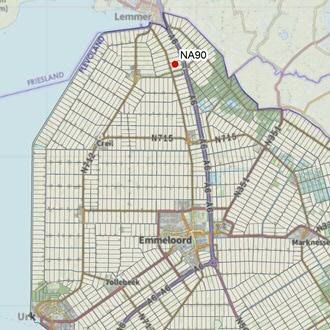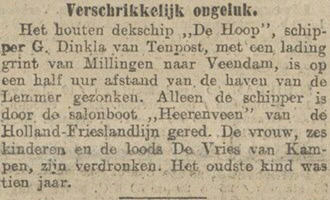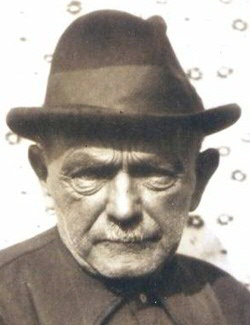Two Zuiderzee shipwrecks identified and their demise unravelled
It has never been possible to identify two shipwrecks in the Zuiderzee at the same time, let alone link the downfall of both ships. Until now. Maritime archaeologist Yftinus van Popta from the University of Groningen has managed to analyse data relating to two Zuiderzee shipwrecks and unravel the story behind the two sinkings. A tragic history, in which Queen Wilhelmina herself became involved.
Every abstract shipwreck conceals a story of personal suffering
The Province of Flevoland is the largest land-based ship cemetery in the world. Over 450 shipwrecks that were found on the former seabed have been analysed. Most of them are fairly abstract, incomplete wooden structures, bearing no evidence of the names of the ships, the reason that they sank and what happened to those on board. ‘Every shipwreck represents a maritime disaster and personal suffering,’ explains Van Popta. ‘But it is often difficult to work out what happened. Discovering the name of a ship is a good starting point, but this usually remains a mystery. If you do find the name of the ship, you can sometimes discover the drama that played out on the linear landscape that is now used to grow potatoes and onions.’

Eagle-eyed labourer forced to rebury the shipwreck
When the Noordoostpolder was pumped dry in the 1940s, labourers dug thousands of ditches and trenches to drain the groundwater from the land. While digging in plot A90 close to Rutten, a labourer called Ten Cate discovered two shipwrecks. One of them bore the name the ‘Drie Gebroeders’ (Three Brothers). He reported the discovery to his foreman. As they were behind in their work and shipwrecks were commonplace, the foreman instructed Ten Cate to rebury the wrecks in the soil. But Ten Cate felt the need to report his discovery to the then-maritime archaeologist. Eight years later, the archaeologist finally found time to go and inspect the site of the shipwrecks, but all traces had vanished. They had possibly been secretly removed.
The Drie Gebroeders is rediscovered
Using modern spatial and archaeo-historic research methods, Van Popta has now established that the first shipwreck that was unearthed on plot A90 was indeed the ‘Drie Gebroeders’. It was a type of inland sailing vessel known as a tjalk, built in 1878 and owned by the ship master Sije Geerts van Dijk (46) from Lekkum. He and his wife Jantje van Dijk (36) and their four children Geert (15), Albertje (14), Gooitzen (12) and Errit (7) had sailed onto the Zuiderzee in the early morning of 28 June 1909, when their ship hit an obstacle and sank. Local fishermen rushed to the scene to save those on board, but the ship itself sank. It soon became clear that the Drie Gebroeders had hit another ship - the second wreck that Ten Cate had found on plot A90 -, which had sunk at the same place several months previously. Van Popta was also able to reconstruct this story.

The tragic tale of the old ship De Hoop
On Monday 19 April 1909, ship master Geert Dinkla (37) from Ten Post sailed out of Kampen heading for Veendam in his old ship ‘De Hoop’. The weather conditions were poor. On board with him were his wife (35), six children (aged from 18 months to 10 years), and a servant (47) from Kampen. Just south of Lemmer, the ship got into trouble in rough seas: the hatches were blown open and the ship started taking on seawater. A sudden gust of wind hit the roof of the cabin where Dinkla's wife and children were sheltering. Dinkla fell overboard, but managed to cling onto a barge. He watched helplessly as his ship and family disappeared into the depths of the sea. Their bodies were not found for several weeks. This tragic news reached as far as Queen Wilhelmina, who sent a telegram expressing her condolences and promising financial support for Dinkla and the servant’s next of kin.

Ghost ships
Van Popta has calculated that Flevoland is probably concealing dozens of these ‘ghost ships’ (wrecks that have disappeared). ‘It’s possible that the shipwrecks were removed, but archaeological finds in the areas concerned, and reconstructions of the stories of their demise, seem to point to this being their final resting place. This is exactly what is needed to bring the maritime history of the polders back to life.’
Contact and more information
| Last modified: | 15 December 2020 08.39 a.m. |
More news
-
26 September 2024
Defne Abur brings innovative speech research to the YAG
Defne Abur, assistant professor of Speech and Speech Technology, has joined the Young Academy Groningen (YAG). With a unique interdisciplinary background and a commitment to societal inclusion, she is set to make significant contributions,...
-
02 September 2024
Preserving the web for researchers of the future
How do you archive the internet? What are you going to keep and what are you not going to keep? And who decides this? These are questions that Susan Aasman thinks about on a daily basis. The media historian and Professor of Digital Humanities at...
-
02 September 2024
Come to the Arts Festival for science, stories, music, and more
On Saturday, September 21, the Faculty of Arts at the University of Groningen will host the Literature Festival, a scientific event for anyone interested in the diverse world of the humanities. The Harmonie Building and the surrounding squares will...
